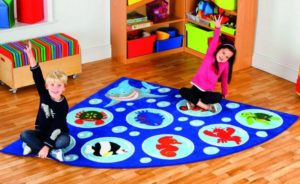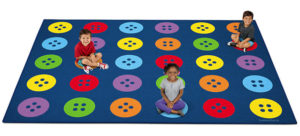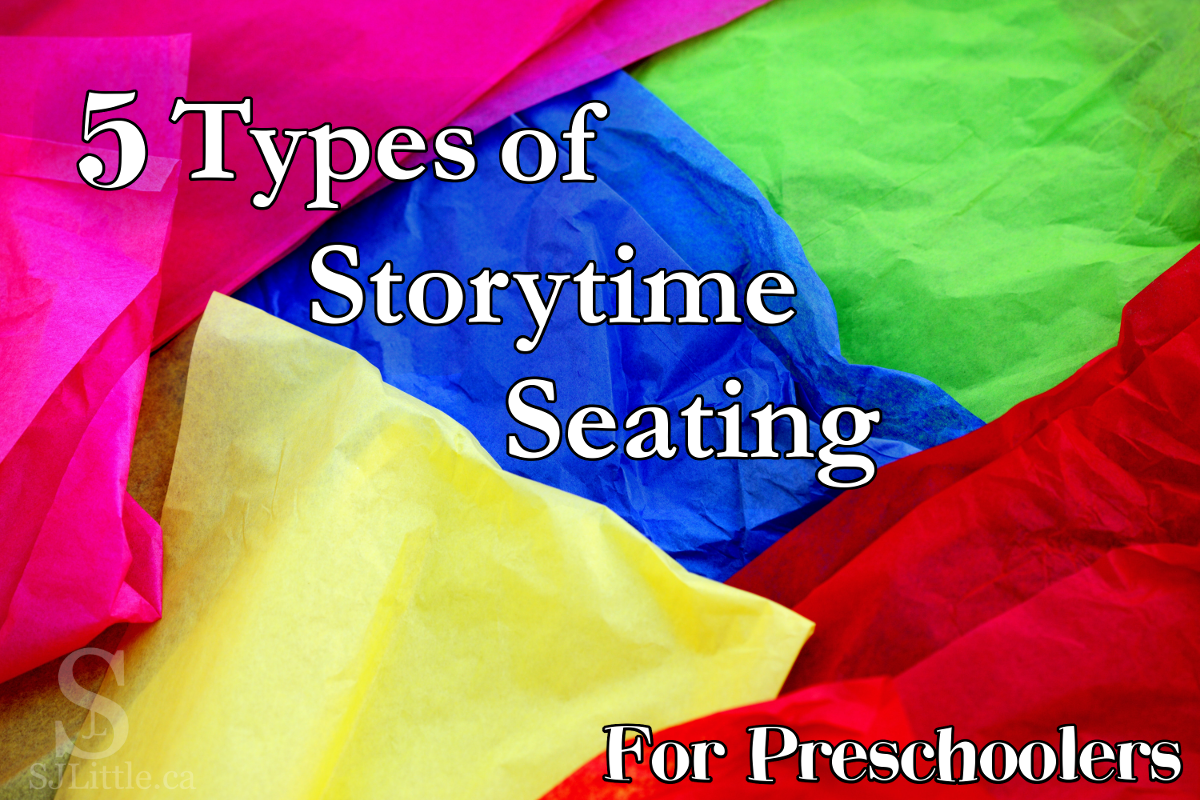
Circle time. That point when the entire class gathers around the teacher for songs, stories, and activities.
This can be a tricky part of the day for the teacher, as the children wiggle and get distracted by their friends. Different seating arrangements can help eliminate certain distractions. Also, different seating arrangements work better in different environments and with different budgets. Here are some pros and cons of 5 unique types of storytime seating for preschoolers that I’ve used.
Note: the images included are for your reference. They do not indicate any partnership with or recommendation for those specific carpets and/or companies. The links are not affiliate links.
1. Small carpet (with no individual spots)
- This could be any rug you have around that is big enough for all the children to sit on. I have seen blankets or bamboo mats used as well.
- Pros:
- Use what you have, rather than buying a new expensive rug
- Can fit a large number of children on a smaller space since there aren’t individual spots to sit on
- Gives the children a defined area to sit during storytime
- Cons:
- Beware, rugs with very colourful designs can make it hard to spot toys, thus making clean up difficult and stepping on toys more likely
- Children may jostle for position and argue since there are no boundaries providing needed personal space
- Children are likely to crowd into multiple rows causing added distraction
- Children have a hard time seeing what the teacher is holding since they are not arranged well
2. Carpet with multiple rows of individual seating spots
- These carpets can be square or designed to fit into a corner like a slice of pizza. Often, if all the spots are filled, you will end up with three rows of children directly behind each other.
- Pros:
- Typically specifically designed for school type settings
- Often high-quality carpets that will last several years
- Often include an educational element such as shapes, or numbers
- Children have specified spots to sit on with the goal of having the seating well-spaced – not too close and not too far
- Multiple sizes designed for different numbers of children are available
- Cons:
- Often expensive
- May be hard to clean
- Can cause difficulties with children kicking those in the row in front of them
- Back row of children often are not as attentive to the teacher
3. Large oval or rectangular rug (with seating spots)
- These are very standard storytime seating for preschools to have. There are many different designs from letters to woodland animals and more.
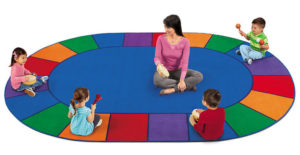
- Pros:
- No back row of children meaning the teacher can see all the children and the children are not distracted the same way as those with multiple rows
- Many beautiful designs to choose from, including educational themes
- Are large enough to accommodate many children
- Individual spots on the rug for children to sit on
- Typically specifically designed for school type settings
- Often high-quality carpets that will last several years
- Cons:
- Your classroom must have a large open space to set this rug
- Difficult to find a place for the teacher to sit where all the children can see (some may be behind another child along the side)
- Depending on where the teacher sits, some children will be sitting a considerable distance from the teacher making it difficult to see what the teacher is holding, or for the teacher to hear the child talking
- Most are very heavy if you have to move them
- Can be difficult to clean
- Typically expensive
4. Individual story spots or carpets
- Story spots come in a wide variety of shapes, sizes, and colours. They may be individual sized squares of carpet, or circle shaped cushions. They could even be laminated pieces of paper. The thing that makes them all fit in the same category is that they are one spot per child and that they are movable.
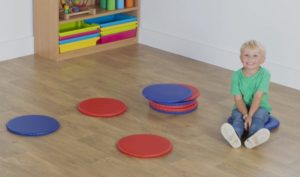
- Pros:
- Spots can be rearranged to whatever shape fits your space.
- Can be stacked on the shelf during playtime allowing more space for toys
- Might be machine washable
- You choose how many to use rather than always having 12 spots if you only have 10 children.
- Cons:
- Spots are not secured to the floor allowing children to move them around which can be distracting
- Creates an extra task for the teacher (or children) to set them up and put them away every day
- If used on hard floor, the spots may be slippery if stepped on
- Can be expensive
5. Tape
- Rather than buying a rug, take a roll of masking tape and put it on the floor in a large “u” or semi-circle around the teacher’s chair. The children will sit on the tape. (Alternatively cut pieces of paper and use clear tape to secure them to the floor)
- Pros:
- Inexpensive
- Can be placed in any shape, according to your needs
- Can adjust length of tape to accommodate any size of class
- Children do not argue over getting their favourite colour or letter
- No second row (unless you want to make one)
- No heavy rug or stack of story spots to deal with
- Cons:
- Children may pick at the tape and pull it off
- Lack of individual spots means the children sometimes sit too close to each other causing irritation
- Leaving the tape down for several weeks, or during deep cleaning, may leave lines on the floor
- Tape will need to be replaced from time to time as it wears out or the children pull it off
- Not ideal on hard floor as it does not protect children from hard surfaces or cold floors
That’s a long list of pros and cons to consider. If you were to ask me which storytime seating for preschoolers I prefer, I would likely say using tape is my preference. However, this, of course, depends on the program and the space available.
What is your preferred storytime seating for preschoolers? Can you think of pros or cons I didn’t include in this post?
Struggling to keep your children engaged at storytime? Here are some helpful ideas:

